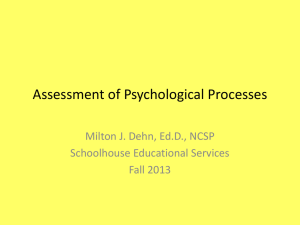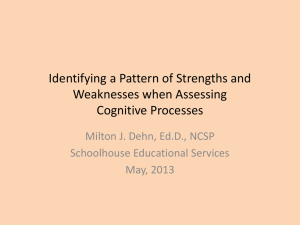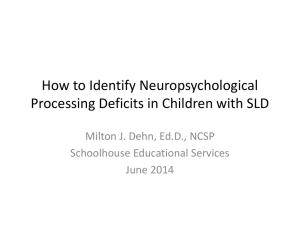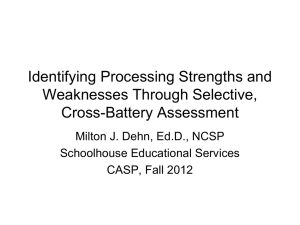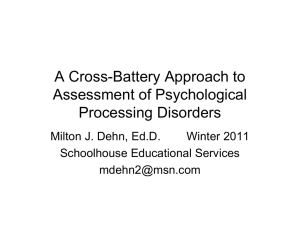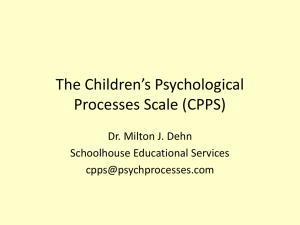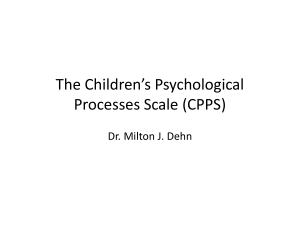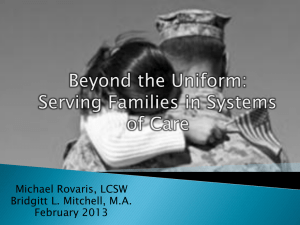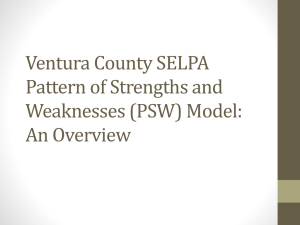PSW KASP
advertisement
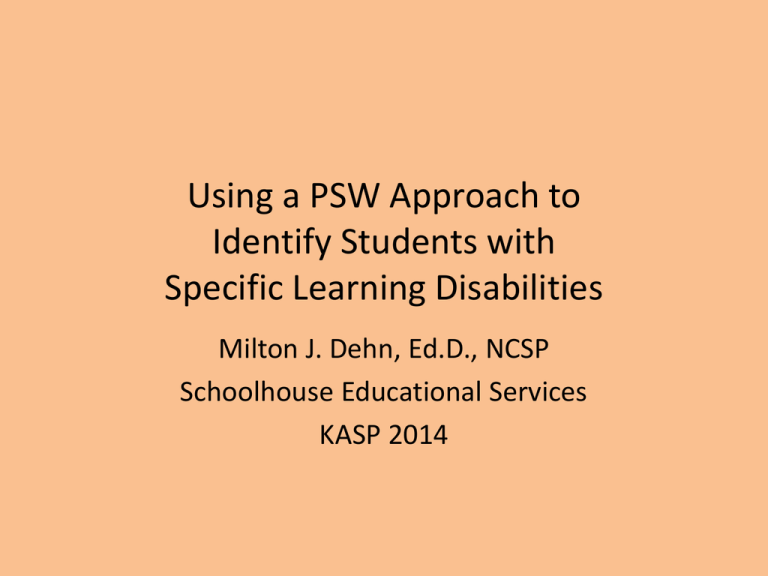
Using a PSW Approach to Identify Students with Specific Learning Disabilities Milton J. Dehn, Ed.D., NCSP Schoolhouse Educational Services KASP 2014 Notice of Copyright 2014 This PowerPoint presentation and accompanying materials are copyrighted by Schoolhouse Educational Services, LLC. They are not to be reprinted, copied, or electronically disseminated without written permission. To obtain permission, email milt@psychprocesses.com. Workshop Information Sources • Essentials of Processing Assessment, 2nd Ed. • Children’s Psychological Processes Scale (CPPS) • Psychological Processing Analyzer (PPA) • www.psychprocesses.com • Intervention references • Presenter Contact: milt@psychprocesses.com Topics 1. 2. 3. 4. 5. 6. 7. 8. Processes to assess Processes and academic skills PSW Models Conducting a processing assessment Completing the processing analysis worksheet Identifying processing deficits with the PPA CPPS overview Processing interventions overview The Need for Processing Assessment 1. Part of a neuropsychological approach 2. Not just for SLD but Autism, ADHD, TBI, etc. 3. Neuroscience has increased our understanding of brain-learning relationships 4. A deficit in a “psychological process” is part of federal and states’ SLD definitions 5. Identification of processing deficits leads to more appropriate & effective interventions Working Memory Example 1. 10% of children have a WM deficit 2. Of those in the bottom 10% percentiles, 80% will have significant learning problems 3. A working memory deficit predicts LD with more than 80% accuracy 4. WM predicts LD better than IQ, consistency predicts better than discrepancy 5. WM evidence-based interventions It’s About the “Why” 1. The “why” matters 2. Learning disabilities have a neurological basis 3. Understanding the brain basis as to why a student has a learning disability is important 4. Identifying processing deficits is a big part of answer the why question 5. Assessment that answer some why questions benefits the learner even without placement or interventions Processing Assessment and RTI 1. Both value early identification 2. When RTI fails, a processing deficit is probably the cause 3. Addressing processing deficits makes academic interventions successful; example 4. Much has changed/improved in regards to processing assessment and intervention What are Neuropsychological Processes? 1. 2. 3. 4. 5. 6. 7. 8. Brain processes, operations, functions Whenever information is perceived, transformed, manipulated, stored, retrieved, expressed Include “cognitive” processes Whenever we think, reason, problem-solve There are basic and higher level processes Doesn’t include knowledge or achievement Learning and performance depend on these processes; they underlie academic skill acquisition There are social-emotional, sensory, and other processes that are not included for SLD assessment Neuropsychological Processes are Not 1. IQ, but they contribute to IQ 2. “Abilities”; are the specific brain processes that underlie abilities 3. More like aptitudes than abilities; aptitudes are more specific 4. Not skills; skills and knowledge are the product of processes Processes to Include in Assessment 1. Broad processes composed of numerous subprocesses – Consider subprocesses when a broad process is low 2. Related to academic learning & performance 3. Observable in the classroom 4. They have evidence-based interventions Processes for SLD Assessment 1. Attention 2. Auditory Processing 3. Executive Functions 4. Fine Motor 5. Fluid Reasoning 6. Long-Term Recall 7. Oral Language 8. Phonological Processing 9. Processing Speed 10.Visual-Spatial Processing 11.Working Memory (WM) Human Processing Limitations 1. Human limitations 2. Which processes does the chimp excel at? Attention 1. 2. 3. 4. Types: Selective, focused, divided, sustained Necessary for learning and memory Attention deficits part of LD; ADHD/LD comorbidity Not necessarily ADHD (not enough symptoms) 1. ADHD is more hyperactive/impulsive 2. Inattentive type is more cognitive/learning problems 5. Can use rating scales to assess attention 6. Related to Executive Functions and Working Memory Executive Functions 1. Self-regulation of cognitive functions and psychological processes 2. There are more than 30 exec processes 3. Self-monitoring, self-regulation, and metacognition are part of EF 4. Have a longer course of development 5. Also have to do with classroom performance 6. Can assess with rating scales Long-Term Recall 1. The focus is on the processes, not the amount of acquired knowledge 2. Close connection with other processes and with academic learning in general 3. Includes encoding, consolidation, storage, and retrieval 4. Don’t need memory battery; can use scores from WJ and other scales Working Memory 1. 2. 3. 4. 5. Processing while retaining information Includes short-term memory Verbal, visual-spatial, & executive WM WM is a cognitive and executive process Scores from WJ, IQ, and other cognitive scales can be used 6. An example of where CHC theory does not match up with neuropsychology; WJ IV has made an adjustment Neuroanatomy of Processes Neuroanatomy of Processes 1. 2. 3. 4. Most in more than one brain lobe Illustrates the interconnectivity of processes Most have specific structures within a lobe Processing speed is a function of interconnectivity; does not have a specific structure Occipital Lobe 1. Dedicated to vision and visual-spatial processing 2. Receives sensory data from the thalamus 3. Visual and spatial processing are separate 4. Dorsal stream (upper) sends spatial information to parietal lobe 5. Ventral stream (lower) sends visual information to temporal lobe Temporal Lobe 1. Auditory processing 2. Long-term memory processing in the hippocampus 3. Some visual processing 4. Semantic memory storage The Hippocampus Parietal Lobe 1. Integrates sensory information 2. Language processing 3. Phonological processing Frontal Lobe 1. 2. 3. 4. 5. 6. 7. 8. The “output” lobe; others are input Executive functions---prefrontal cortex Working memory---prefrontal cortex Attentional control---prefrontal cortex Fluid reasoning Fine motor Oral expression No storage of long-term memories Brain Lobes and STM & WM 1. Frontal (Prefrontal Cortex): Executive WM 2. Temporal: Episodic WM (especially during LTM encoding and retrieval) 3. Parietal Lobes: Phonological STM and Verbal WM in language processing areas 4. Occipital Lobes: Visuospatial STM and WM The Evidence for the SLD-Processing Deficit Connection Meta-Analysis of 32 studies by Johnson et al. (2010) found “moderately large to large effect sizes (many close to one standard deviation of difference) in cognitive processing differences between groups of students with SLD and typically achieving students.” The processes included were: Working memory, short-term memory, phonological processing, processing speed, executive function, and language.” The SLD-Processing Connection from Study with the CPPS 1. LD subjects had significantly higher means on all 11 processes; about 1.5 SD difference Link Processes and Academic Learning 1. Psychological processes are like “aptitudes” 2. Relations established through research – Flanagan et al., & McGrew – Swanson, Geary, and others 3. For SLD look for academic area and related psychological processes to both be low 4. See Table; useful for planning, interpretation, and diagnosis Research Example: SLD by Processing Subtypes 1. Visual-Spatial Deficits: Math calculation and math problem solving 2. Processing Speed Deficits: Reading comprehension, written expression 3. Working Memory Deficit: Math calculation, Written expression 4. Attention: Written expression Source: Hain, Hale, Kendorski The Origin of PSW 1. IDEIA 2004 Federal Regulations define SLD as “a disorder in one or more of the basis psychological processes” 2. First method: IQ-Achievement Discrepancy 3. Second method: RTI 4. The third method allowed for SLD identification using “alternative researchbased procedures” The Third Method Flanagan interpreted this as allowing the use of a “pattern of strengths and weaknesses” in achievement, cognitive abilities, or psychological processes, with an emphasis on psychological processes SLD and PSW 1. Assumption: a neurologically-based processing weakness underlies or “causes” learning disabilities (Hale & Fiorello, 2004) 2. The occurrence of significant intra-individual processing weaknesses indicates SLD 3. The “why” matters Jack Naglieri’s Model Concordance-Discordance Model 1. From James Brad Hale Link 2. Similar to Naglieri’s model 3. Processing areas not significantly related to the academic area should be discordant: Processing strengths should be significantly higher than the academic weakness CHC Model 1. A process related to the academic deficiency is weak or deficient 2. Unexpected underachievement: Process and academic deficit exist with otherwise normal ability 3. Regarding strengths, at least some processes should be in the average range PSW & SLD: The “Minds” Consensus 1. 2. 3. 4. 5. 6. 7. 8. Neurologically-based deficits underlie SLD There’s no SLD if there’s no processing deficit Some processes highly related with academic skills Processing deficits related to academic deficits SLD have average or near average cognitive ability Weakness should be normative & intra-individual Weakness: statistically significant and unusual PSW doesn’t mean there is a learning disability. Dehn’s PSW Model 1. 2. 3. 4. 5. 6. Intra-individual processing weaknesses are statistically significant At least one process is a deficit (see definition) The processing deficit is related to the deficient academic skill Consistency between low process score(s) and the related low academic skill score Subtest scores must be unitary for a deficit There is at least one strength (or a processes that is in average range) Dehn’s Definition of Deficit 1. Normative weakness + intraindividual weakness = deficit 2. Three reasons for deficit emphasis – Both weaknesses together is statistically rare – A deficit indicates an underlying neurological impairment – Students with both kinds of weaknesses really need special ed. Process Scores Allowed in Dehn’s Model 1. 2. 3. 4. The list of 11 processes Rating scales are included Composite scores preferred over subtests Achievement-like scores, e.g., verbal, crystallized intelligence, vocabulary excluded 5. Some subtests are re-classified CHC vs Dehn’s Model 1. Dehn’s uses processes that have the highest relations with academic learning even if they are narrow processes 2. Dehn has more specific criteria for using processing deficits to identify SLD 3. Both use cross-battery analysis but Dehn offers IQ as a optional predictor 1. IQ score more reliable than cross-battery mean Single Battery Testing 1. 2. 3. 4. One battery is sufficient if it is comprehensive Examples: NEPSY-II, Woodcock-Johnson Cog. With NEPSY-II, use Dehn’s analysis worksheet With WJ, use the intra-cognitive discrepancy analysis table Link Cross-Battery, Selective Testing 1. 2. 3. 4. 5. 6. 7. Start with batteries you have Try to limit number of supplemental batteries Avoid redundancies Only selected subtests administered Two subtests or composites are ideal May include rating scales Use cross-battery analysis procedures Cross-Battery, Selective Testing 1. Test all processes important for academics with most attention to an in-depth assessment of hypothesized weaknesses 2. Pick composites first 3. See selective testing table Link 4. See comprehensive list link from Essentials of Processing Assessment, 2nd Edition Some Subtests are Classified Differently Through Task Analysis 1. Consider definition of the process 2. Consider factor analytic information 3. What is the primary process being measured by the subtest? (not just input or output) 4. Which primary process allows the examinee to successfully complete the task 5. What the task is typically used to measure 6. No such thing as “pure” subtest measure Hypothesis Testing Approach 1. Given academic deficiency, what are the most likely process deficits 2. It’s “why” the child has a learning problem 3. Include non-processes 4. Must collect assessment data to “test” hypotheses 5. Try to avoid “confirmatory bias” 6. We all have weaknesses Planning Processing Assessment 1. Assess most major processes, especially those hypothesized to be deficits 2. Don’t test areas that are clearly strengths 3. Use the CPPS to reduce need to test 4. Identify academic deficiencies 5. Generate processing deficit hypotheses based on relations with academics 6. Decide on assessment method 7. Select tests and subtests, not entire batteries Planning a Processing Assessment 1. Complete the processing assessment planner on case study 2. Consider concern; look at academic relations table; hypothesize which processes involved 3. Consider non-processing hypotheses 4. Fill in all processes tested by primary scale 5. Find other scales to cover remaining processes See Partially Completed Example Case Study Risk Factors 1. 2. 3. 4. 5. 6. 7. Blood clot in umbilical cord Abusive father; stressful home environment ADHD Executive dysfunctions but very self-aware Speech/language delay and disorder Seizure disorder Severe word retrieval difficulties Six-Year Old Case Study Concerns 1. 2. 3. 4. 5. 6. 7. 8. Learning colors, letters, and numbers Inconsistent performance Recognizing and generating rhyming words Reading difficulties Doesn’t remember directions Difficulty getting started on a task Word retrieval problems Math learning difficulties Processing Analysis with Hand Computations 1. Use composite scores from test manual whenever possible 2. Convert all scores to standard scores 3. Compute clinical scores by averaging 4. Compute processing or memory mean or use IQ 5. Calculate discrepancies 6. Determine weaknesses and deficits 7. Both kinds of weaknesses = a deficit 8. Do pairwise comparisons – Opposites and those closely related 9. Example Guidelines for Weaknesses & Deficits 1. Deficit = both normative and intra-individual weakness 2. Scores below 90 are normative weaknesses – Below 85 if not using deficit approach 3. Intra-individual strengths & weaknesses use 12 points – Assumes composites/subtests have hi reliability – Use 15 points if not using deficit approach Non-Unitary Scores 1. When standard score difference is greater than 22 points 2. Something different is being measured or something is different about the task 3. Investigate further with more testing if cannot be explained 4. Don’t use a non-unitary process score for diagnostic purposes Pairwise Comparisons 1. For intervention planning, not diagnosis 2. Pay most attention to: – Opposites – Those that are closely related 3. A greater discrepancy is required for significance 4. Significant when confidence intervals do not overlap PSW SLD Criteria for Case Study 1. Is there at least one deficit 2. Is there at least one strength 3. Is the intra-individual weakness statistically significant 4. Are the scores unitary 5. Does the deficit relate to the deficient skill 6. Is there consistency between the process and achievement score (bands overlap) When to Use IQ Instead of CrossBattery Mean 1. Okay to use IQ as predictor because it has high correlations with most processes 2. Is technically more appropriate because it has known reliability and SEM 3. Use when only weak processes tested 4. Use when only a few processes tested 5. Use when a legal challenge is anticipated Using Dehn’s Automated Analysis Worksheet to Determine PSW 1. Automated worksheet from Essentials of Processing, 2nd Edition Psychological Processing Analyzer 2.1 and 3.0 1. Available at www.psychprocesses.com 2. Identifies statistically significant strengths, weaknesses, deficits, and assets 3. Can enter composite and/or subtest scores 4. 11 psychological processes 5. Takes scores (about 400 to choose from) from 50+ different scales: cognitive, achievement, rating, and processing Psychological Processing Analyzer 1. Composite and subtests are limited to those that are fairly direct measures 2. Some are re-classified based on the primary demands of the task 3. Use the mean of the process scores or IQ as predicted score 4. Differences greater than critical values are intra-individual weaknesses PPA Equations 1. Converts all scores (except raw scores) to standard scores 2. .01 or .05 level of significance 3. Difference formulas based on reliability coefficients of composites/subtests 4. Regression toward the mean 5. Predicted score based on mean of other 10 6. Non-unitary scores are flagged 7. Checks processes and achievement for consistency PPA Report 1. Pairwise comparisons also provided 2. Results tables, graph and narrative 3. Identifies academic areas associated with the identified deficits 4. See demo and sample report New Features with PPA 3.0 1. New tests such as WISC-V and WJ IV 2. Will do cross-battery intra-achievement analysis 3. Will select deficit processes and deficit academic skills that pair up (related) 4. Check them for statistical consistency 5. Longer narrative with definitions, etc. Using Rating Scales for Processing Assessment 1. Processing deficits are manifested through behaviors 2. Behavior ratings can be used to measure processing abilities 3. Research: rating scales just as valid if not more so for some processes 4. Examples: BRIEF and other Executive Function Scales 5. Also, the new CPPS Children’s Psychological Processes Scale (CPPS) Overview 1. 2. 3. 4. 5. 6. 7. Standardized teacher rating scale Ages 5-0-0 to 12-11-30 121 items across 11 subscales Entirely online, internet-web based Online administration time of 15 minutes Online scoring and report Author: Milton Dehn; published by Schoolhouse Educational Services, 2012 8. Measurement Consultant: Kevin McGrew Main Uses of the CPPS 1. To identify psychological (cognitive) processing weaknesses in children referred for a learning disability evaluation 1. An additional source of data for diagnostic purposes 2. Can be used as a Pattern of Strengths and Weaknesses (PSW) analysis 3. Covers processes not directly tested 4. Progress monitoring 5. Screening CPPS Standardization 1. 2. 3. 4. 5. 6. 1,121 students rated by 278 teachers 128 communities in 30 states All data collected online Demographics match U.S. Census well Norms: 4 age groups (5-6; 7-8; 9-10; 11-12) Included children with disabilities The CPPS Identifies Children with SLD 1. LD subjects had significantly higher means on all subscales; about 1.5 SD difference 2. The CPPS has high classification accuracy in regards to LD 1. 37 LD subjects compared with matched controls 2. Using CPPS GPA cutoff of 60 had 92% classification accuracy across 74 subjects CPPS Processes 1. Attention 2. Auditory Processing 3. Executive Functions 4. Fine Motor 5. Fluid Reasoning 6. Long-Term Recall 7. Oral Language 8. Phonological Processing 9. Processing Speed 10.Visual-Spatial Processing 11.Working Memory (WM) CPPS Report 1. 2. 3. 4. Brief narrative, graph, and a table of scores Change-sensitive W-scores T-scores; percentiles; confidence intervals Intra-individual strengths and weakness discrepancy table 5. T-score to standard score converter 6. Example CPPS Discrepancy Analysis 1. Use discrepancy table to determine pattern of strengths and weaknesses 2. Predicted score based on mean of other 10 3. Regression toward the mean included 4. +/- 1.00 to 2.00 SD of SEE discrepancy options 5. Strengths and Weakness labeling is opposite of discrepancy, e.g. “-” value = a strength 6. Link Diagnosing LD with the CPPS 1. Look for pattern of strengths and weaknesses (discrepancy table) 2. If intra-individual weaknesses are also normative weaknesses (T-scores of 60 and above), then they are deficits 3. Same criteria as PSW model Using Assessment Results to Plan an Intervention 1. Select processing deficits and intraindividual weaknesses for intervention 2. Normative weaknesses also appropriate 3. Consider related processing weaknesses 4. Consider executive and WM limitations 5. Prioritize 6. Individualize and differentiate Interventions for Processing Weaknesses & Deficits 1. Strengthen weakness if possible 2. And utilize the strong areas more 3. Use methods that involve other processes, more of the brain 4. Principle: make the brain work, it gets better 5. Also need accommodations that reduce the need to use the weak processes, especially when deficits are severe See Summary Sheet with References • More methods and references for WM and long-term memory Link Metacognitive Component 1. 2. 3. 4. 5. 6. Applies to all processing interventions Teach child how process works Inform child of strengths and weaknesses Teach how to control the process Emphasize personal efficacy of intervention Teach conditional strategy knowledge: how, when, where, why Attention: Self-Monitoring 1. Teacher, or device carried by student, cues student at variable intervals, such as 5 minutes 2. When cued, student marks monitoring sheet regarding behavior when cue occurred: 2Completely on task; 1-Partially on task; 0Completely off task 3. When teacher is cueing, she also provides her rating alongside student’s; student receives bonus point when ratings match 4. Set a points goal that student is working for, easy at first, then keep adjusting upward Link Auditory Processing 1. Same as interventions for CAPD 2. Recoding auditory into visual information 3. Visual representations should accompany verbal presentations 4. Quiet environment 5. Improve acoustics 6. Fast ForWord 7. Auditory trainers (individual sound systems) Executive Functions: Planning 1. Developing planning improves math performance 2. Discuss benefits of plans 3. Develop plans 4. Verbalize them 5. Implement them and evaluate Fluid Reasoning 1. 2. 3. 4. Problem solving Categorizing Similarities and differences Games that require reasoning and recognizing relationships Phonological Processing 1. Phonemic awareness interventions very effective .86 effect size (the earlier the better) 2. Oral at first, then with written material 3. Rhyming; isolating phonemes; identifying phonemes; deleting phonemes; categorizing common phonemes; segmenting phonemes that comprise words; and blending phonemes into words Processing Speed • Video Games Visual-Spatial Processing • None recommended Long-Term Recall 1. Dual encoding 2. Elaboration 3. Visual mnemonics Dual Encoding 1. Instructors should make it both verbal and visual or give students time to recode 2. Instruct students to visualize verbal info. 3. Instruct students to name/describe visualspatial info. 4. Increases the number of pathways available for retrieval Verbal Memory Strategy: Elaboration 1. Relate new info. with previous 2. Facilitates encoding and LTM organization, consolidation, retrieval 3. Teachers should provide for young child 4. In-depth versus superficial processing 5. Ties info. with appropriate schema 6. Example: Asking and answering the “Why does this make sense” question Visual Mnemonics 1. For students with low verbal WM 2. Link info to something already known that will not be forgotten; Act as a scaffold or bridge 3. Creates associations and meaning 4. Best when student creates images 5. Interactive images best 6. Ideal for those with verbal WM deficit 7. Basic visualization without a mnemonic is also beneficial Link Approaches to Improving WM 1. Reduce the “cognitive load” imposed on the student (Tier I) 2. Directly increase WM capacity through the use of training exercises (Tiers II and III) 3. The student can make more effective use of existing WM capabilities by learning to use strategies (Tiers 1 – 3) 4. Accommodations
